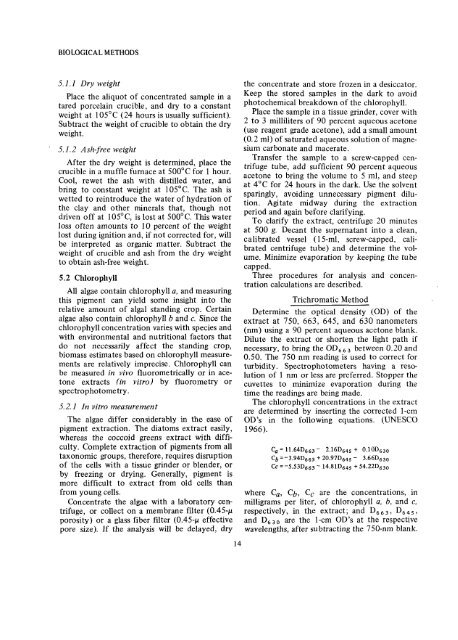Biological field and laboratory methods for measuring the quality of ...
Biological field and laboratory methods for measuring the quality of ...
Biological field and laboratory methods for measuring the quality of ...
You also want an ePaper? Increase the reach of your titles
YUMPU automatically turns print PDFs into web optimized ePapers that Google loves.
BIOLOGICAL METHODS<br />
5.1.1 Dry weight<br />
Place <strong>the</strong> aliquot <strong>of</strong> concentrated sample in a<br />
tared porcelain crucible, <strong>and</strong> dry to a constant<br />
weight at 105°C (24 hours is usually sufficient).<br />
Subtract <strong>the</strong> weight <strong>of</strong> crucible to obtain <strong>the</strong> dry<br />
weight.<br />
5.1.2 Ash-free weight<br />
After <strong>the</strong> dry weight is determined, place <strong>the</strong><br />
crucible in a muffle furnace at 500°C <strong>for</strong> 1 hour.<br />
Cool, rewet <strong>the</strong> ash with distilled water, <strong>and</strong><br />
bring to constant weight at 10S°e. The ash is<br />
wetted to reintroduce <strong>the</strong> water <strong>of</strong> hydration <strong>of</strong><br />
<strong>the</strong> clay <strong>and</strong> o<strong>the</strong>r minerals that, though not<br />
driven <strong>of</strong>f at 105°C, is lost at SOO°C. This water<br />
loss <strong>of</strong>ten amounts to 10 percent <strong>of</strong> <strong>the</strong> weight<br />
lost during ignition <strong>and</strong>, if not corrected <strong>for</strong>, will<br />
be interpreted as organic matter. Subtract <strong>the</strong><br />
weight <strong>of</strong> crucible <strong>and</strong> ash from <strong>the</strong> dry weight<br />
to obtain ash-free weight.<br />
5.2 Chlorophyll<br />
All algae contain chlorophyll a, <strong>and</strong> <strong>measuring</strong><br />
this pigment can yield some insight into <strong>the</strong><br />
relative amount <strong>of</strong> algal st<strong>and</strong>ing crop. Certain<br />
algae also contain chlorophyll b<strong>and</strong> c. Since <strong>the</strong><br />
chlorophyll concentration varies with species <strong>and</strong><br />
with environmental <strong>and</strong> nutritional factors that<br />
do not necessarily affect <strong>the</strong> st<strong>and</strong>ing crop,<br />
biomass estimates based on chlorophyll measurements<br />
are relatively imprecise. Chlorophyll can<br />
be measured in vivo fluorometrically or in acetone<br />
extracts (in vitro) by fluorometry or<br />
spectrophotometry.<br />
5.2.1 In vitro measurement<br />
The algae differ considerably in <strong>the</strong> ease <strong>of</strong><br />
pigment extraction. The diatoms extract easily,<br />
whereas <strong>the</strong> coccoid greens extract with difficulty.<br />
Complete extraction <strong>of</strong> pigments from all<br />
taxonomic groups, <strong>the</strong>re<strong>for</strong>e, requires disruption<br />
<strong>of</strong> <strong>the</strong> cells with a tissue grinder or blender, or<br />
by freezing or drying. Generally, pigment is<br />
more difficult to extract from old cells than<br />
from young cells.<br />
Concentrate <strong>the</strong> algae with a <strong>laboratory</strong> centrifuge,<br />
or collect on a membrane filter (O.4S-M<br />
porosity) or a glass fiber filter (0.45-M effective<br />
pore size). If <strong>the</strong> analysis will be delayed, dry<br />
14<br />
<strong>the</strong> concentrate <strong>and</strong> store frozen in a desiccator.<br />
Keep <strong>the</strong> stored samples in <strong>the</strong> dark to avoid<br />
photochemical breakdown <strong>of</strong> <strong>the</strong> chlorophyll.<br />
Place <strong>the</strong> sample in a tissue grinder, cover with<br />
2 to 3 milliliters <strong>of</strong> 90 percent aqueous acetone<br />
(use reagent grade acetone), add a small amount<br />
(0.2 ml) <strong>of</strong> saturated aqueous solution <strong>of</strong> magnesium<br />
carbonate <strong>and</strong> macerate.<br />
Transfer <strong>the</strong> sample to a screw-capped centrifuge<br />
tube, add sufficient 90 percent aqueous<br />
acetone to bring <strong>the</strong> volume to 5 ml, <strong>and</strong> steep<br />
at 4°C <strong>for</strong> 24 hours in <strong>the</strong> dark. Use <strong>the</strong> solvent<br />
sparingly, avoiding unnecessary pigment dilution.<br />
Agitate midway during <strong>the</strong> extraction<br />
period <strong>and</strong> again be<strong>for</strong>e clarifying.<br />
To clarify <strong>the</strong> extract, centrifuge 20 minutes<br />
at 500 g. Decant <strong>the</strong> supernatant into a clean,<br />
calibrated vessel (lS-ml, screw-capped, calibrated<br />
centrifuge tube) <strong>and</strong> determine <strong>the</strong> volume.<br />
Minimize evaporation by keeping <strong>the</strong> tube<br />
capped.<br />
Three procedures <strong>for</strong> analysis <strong>and</strong> concentration<br />
calculations are described.<br />
Trichromatic Method<br />
Determine <strong>the</strong> optical density (00) <strong>of</strong> <strong>the</strong><br />
extract at 750, 663, 645, <strong>and</strong> 630 nanometers<br />
(nm) using a 90 percent aqueous acetone blank.<br />
Dilute <strong>the</strong> extract or shorten <strong>the</strong> light path if<br />
necessary, to bring <strong>the</strong> 00663 between 0.20 <strong>and</strong><br />
0.50. The 750 nm reading is used to correct <strong>for</strong><br />
turbidity. Spectrophotometers having a resolution<br />
<strong>of</strong> 1 nm or less are preferred. Stopper <strong>the</strong><br />
cuvettes to minimize evaporation during <strong>the</strong><br />
time <strong>the</strong> readings are being made.<br />
The chlorophyll concentrations in <strong>the</strong> extract<br />
are determined by inserting <strong>the</strong> corrected I-em<br />
OD's in <strong>the</strong> following equations. (UNESCO<br />
1966).<br />
C a = 11.64D66 3 - 2.16D645 + 0.10D63o<br />
cb = -3.94D66 3 + 20.97D645 - 3.66D630<br />
Cc =-5.53D663 - 14.810645 + 54.22D630<br />
where Ca, Cb, Cc are <strong>the</strong> concentrations, in<br />
milligrams per liter, <strong>of</strong> chlorophyll a, b, <strong>and</strong> c,<br />
respectively, in <strong>the</strong> extract; <strong>and</strong> 0663,0645,<br />
<strong>and</strong> 0 630 are <strong>the</strong> I-em OD's at <strong>the</strong> respective<br />
wavelengths, after subtracting <strong>the</strong> 750-nm blank.















